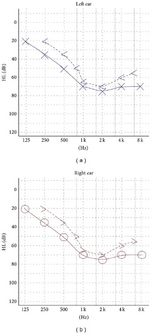Barakat syndrome
| Barakat syndrome | |
|---|---|
| Other names: HDR syndrome[1] | |
 | |
| This condition is inherited in an autosomal dominant manner. | |
Barakat syndrome is a rare disease characterized by hypoparathyroidism, sensorineural deafness and renal disease, and hence also known as HDR syndrome. It was first described by Amin J. Barakat et al. in 1977.[2]
Sign and symptoms
It is a genetic developmental disorder[3] with clinical diversity characterized by hypoparathyroidism, sensorineural deafness and renal disease.[4] Affected people usually present with hypocalcaemia, tetany, or afebrile convulsions at any age.[1] Hearing loss is usually bilateral and may range from mild to profound impairment. Renal disease includes nephrotic syndrome, cystic kidney, renal dysplasia, hypoplasia or aplasia, pelvicalyceal deformity, vesicoureteral reflux, chronic kidney disease, hematuria, proteinuria and renal scarring.[citation needed]
Other reported features include: intellectual disability, polycystic ovaries, particular distinct facial characteristics, ischaemic stroke and retinitis pigmentosa.[4]
Genetics
The defect in the majority of cases has mapped to chromosome 10p (Gene Map Locus: 10pter-p13 or 10p14-p15.1). Haploinsufficiency (deletions) of zinc-finger transcription factor GATA3 or mutations in the GATA3 gene[5] appear to be the underlying cause of this syndrome. It causes the failure in the specification of prosensory domain and subsequently leads to increased cell death in the cochlear duct thus causing deafness.[6]
Since the spectrum of phenotypic variation in affected people is quite large, Barakat (HDR) syndrome probably arises as a low penetrance haploinsufficient disorder in which their genetic background plays a major role in the severity of the disease.[citation needed]
Inheritance is probably autosomal dominant.[4]
Diagnosis

A thorough diagnosis should be performed on every affected individual, and siblings should be studied for deafness, parathyroid and renal disease. The syndrome should be considered in infants who have been diagnosed prenatally with a chromosome 10p defect, and those who have been diagnosed with well defined phenotypes of urinary tract abnormalities.[citation needed]
Treatment
Management consists of treating the clinical abnormalities at the time of presentation and includes genetic counselling, correcting calcium, treating hearing problems, monitoring kidney function and close monitoring of cysts of the kidney.[1][4]
Prognosis
Prognosis depends on the severity of the kidney disease. Life expectancy is unaffected if the disease is mild.[1]
Epidemiology
The frequency is unknown, but the disease is considered to be very rare.[7] Both male and females have been noted to be affected.[1] by hypoparathyroidism, sensorineural deafness, and renal (kidney) disease. However, specific symptoms and severity can vary. Around 65% of people with Barakat syndrome have hypoparathyroidism, sensorineural deafness and kidney disease together.[4]
References
- ↑ 1.0 1.1 1.2 1.3 1.4 "Hypoparathyroidism sensorineural deafness renal disease syndrome". www.orpha.net. Archived from the original on 29 March 2019. Retrieved 29 March 2019.
- ↑ Barakat AY, D'Albora JB, Martin MM, Jose PA (July 1977). "Familial nephrosis, nerve deafness, and hypoparathyroidism". J. Pediatr. 91 (1): 61–4. doi:10.1016/S0022-3476(77)80445-9. PMID 874665.
- ↑ William B. Coleman (9 February 2010). Essential Concepts in Molecular Pathology. Academic Press. pp. 297–. ISBN 978-0-12-374418-0. Archived from the original on 22 January 2022. Retrieved 5 December 2010.
- ↑ 4.0 4.1 4.2 4.3 4.4 "Barakat syndrome | Genetic and Rare Diseases Information Center (GARD) – an NCATS Program". rarediseases.info.nih.gov. National Institutes of Health. 7 September 2018. Archived from the original on 12 November 2019. Retrieved 12 November 2019.
- ↑ Bernardini L, Sinibaldi L, Capalbo A, et al. (July 2009). "HDR (Hypoparathyroidism, Deafness, Renal dysplasia) syndrome associated to GATA3 gene duplication". Clin. Genet. 76 (1): 117–9. doi:10.1111/j.1399-0004.2009.01170.x. PMID 19659764. S2CID 37338806.
- ↑ Luo, X.-j.; Deng, M.; Xie, X.; Huang, L.; Wang, H.; Jiang, L.; Liang, G.; Hu, F.; Tieu, R.; Chen, R.; Gan, L. (10 May 2013). "GATA3 controls the specification of prosensory domain and neuronal survival in the mouse cochlea". Human Molecular Genetics. 22 (18): 3609–3623. doi:10.1093/hmg/ddt212. PMC 3749857. PMID 23666531.
- ↑ Ranjbar-Omrani, G; Zamiri, N; Sabayan, B; Mohammadzadeh, A (May 2008). "Concomitant hypoparathyroidism, sensorineural deafness, and renal agenesis: a case of Barakat syndrome". Archives of Iranian Medicine. 11 (3): 337–40. PMID 18426329.
Further reading
- Gaynor KU, Grigorieva IV, Nesbit MA, et al. (October 2009). "A missense GATA3 mutation, Thr272Ile, causes the hypoparathyroidism, deafness, and renal dysplasia syndrome". J. Clin. Endocrinol. Metab. 94 (10): 3897–904. doi:10.1210/jc.2009-0717. PMID 19723756.
External links
| Classification | |
|---|---|
| External resources |
- Pages with script errors
- All articles with unsourced statements
- Articles with unsourced statements from June 2020
- Articles with invalid date parameter in template
- Articles with unsourced statements from November 2019
- Transcription factor deficiencies
- Congenital disorders
- Rare syndromes
- Syndromes affecting the kidneys
- Syndromes affecting the endocrine system
- Syndromes affecting hearing